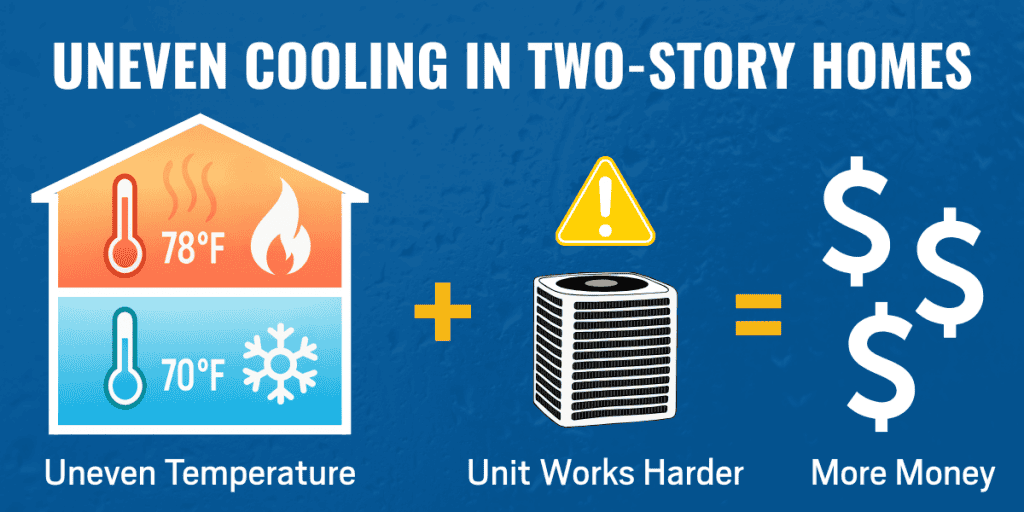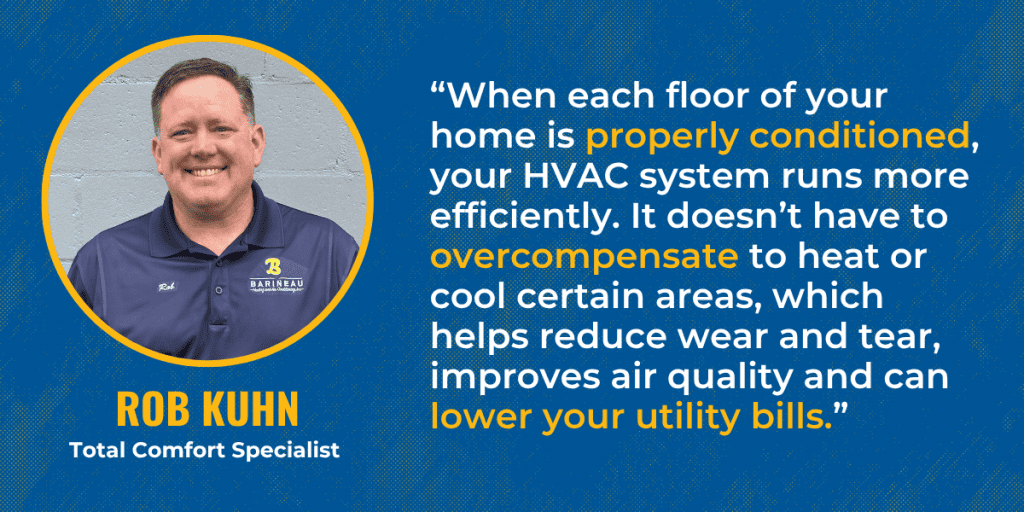
Cooling Upstairs in a Two-Story Home
If you live in a two-story home, you’ve probably faced the common challenge of keeping upstairs cool without turning the downstairs into a freezer. It’s a frequent concern among homeowners and for good reason. Warm air naturally rises, which makes upper floors hotter. But beyond this basic science, other factors like poor insulation or uneven airflow can cause certain rooms to trap heat and stay uncomfortably warm.
The good news? There are practical, effective ways to balance temperatures between floors and improve your home’s overall comfort. Keep reading to discover simple strategies for cooling the second floor of your home without sacrificing comfort downstairs.
Why It’s Warmer Upstairs: Two Key Causes
In multi-story homes, uneven room temperatures are typically caused by two main factors:
First, heat naturally rises, which means upper floors tend to be warmer—especially if your home has only one HVAC system. Without a second unit to balance the load, warm air drifts upward and accumulates.
Second, uneven airflow can make the problem worse. Poor circulation allows warm air to become trapped in certain rooms, making them feel stuffy and uncomfortable.
Addressing both of these issues is key to achieving consistent comfort throughout your home and keeping your second floor cool.

Solutions to Uneven Temperature in Two-Story Homes
If you’re tired of battling hot rooms upstairs and chilly spaces downstairs, you’re not alone. Uneven temperatures in two-story homes are a common frustration, but the good news is there are practical ways to fix it. From improving airflow to upgrading your HVAC system, here are several strategies to help restore comfort throughout your home.
Balancing temperatures starts with better airflow and insulation. Upgrading to a zoned system, adding a smart thermostat and keeping up with regular maintenance can also make a big difference. In some cases, installing a second HVAC unit may be the best solution for lasting comfort and keeping your second floor cool.
Solution #1: Increase Airflow with Ceiling Fans
Ceiling fans are a simple but effective way to improve comfort by enhancing air circulation, especially in two-story homes where temperature differences between floors can be more noticeable. While fans don’t lower the actual temperature, they help distribute air more evenly, making rooms feel cooler in summer and warmer in winter.
Most ceiling fans are multidirectional and include a small switch to change the direction of the blades. In summer, set the fan to spin counterclockwise to create a downdraft, which produces a refreshing breeze. In winter, switch it to clockwise to create an updraft, pushing warm air near the ceiling back down into the room. This is particularly helpful for lower floors where it tends to stay cooler.
By using ceiling fans correctly, you can boost comfort and ease the strain on your HVAC system.
Solution #2: Regular HVAC System Maintenance
If you rely on a single HVAC unit to heat and cool your two-story home, keeping it well maintained is essential. Even if your system seems to be running well, hidden issues such as dirt, dust and debris can cause serious damage over time. Everything from dead leaves to dryer lint can collect in your outdoor unit, leading to clogged cooling fins and dirty condenser coils. This reduces your system’s ability to transfer heat efficiently, making it work harder and driving up your energy bills, especially during peak seasons.
To avoid these problems, schedule annual maintenance and clean or replace air filters regularly to ensure proper airflow and long-term efficiency.
Solution #3: Switch to Zoned Climate Control
Working with an experienced HVAC technician allows you to design a customized comfort system tailored to your home’s unique needs. One popular and cost-effective option is a zoned HVAC system, which offers many of the benefits of a dual-unit setup without the added expense of installing a second heat pump or air conditioner.
With a zoned system, your home is divided into at least two areas (typically the first and second floors) so you can control temperatures independently in each zone. This targeted approach helps improve comfort, increase efficiency and reduce energy costs throughout your home.
Solution #4: Adjust Vent Airflow
Improving airflow is a simple yet effective way to address uneven temperatures between floors. Start by ensuring vents are clear of obstructions such as furniture, dust or debris. Then, consider partially closing some first-floor vents to help redirect more cool air upstairs. This increases static pressure in the ductwork, which encourages conditioned air to flow to warmer areas. However, it’s important to avoid fully closing vents, as this can create too much pressure in your system, potentially leading to duct leaks or damage. Keep in mind that this trick only works if your system is properly balanced. If your HVAC unit isn’t sized or configured correctly, the results may be limited or could even cause new comfort issues.
Some homes have dampers within the ductwork (not just at the registers), which can be adjusted by an HVAC technician for more effective long-term airflow management.
And while it may seem like a good idea to close vents in unused rooms to boost cooling elsewhere, this can disrupt your system’s balance. For the best results, consider a professional assessment or zoning solution to ensure your airflow is optimized throughout your home.
Solution #5: Improve Attic Insulation
Attic insulation plays a crucial role in keeping temperatures consistent throughout your home, especially on the second floor. It acts as a barrier between your living space and the outdoor climate, helping to keep cool air in and hot air out during warmer months.
If your attic lacks sufficient insulation, heat can easily seep into your upper floors, making it harder to cool and forcing your HVAC system to work overtime. Upgrading your insulation not only improves comfort but can also lead to noticeable energy savings over time.
Solution #6: Check and Maintain Ductwork
Your home’s ductwork is responsible for delivering cool air from your HVAC system to every floor. When ducts are old, leaking or insufficient, your system has to work harder to maintain comfortable temperatures, often leading to uneven cooling.
Common issues include leaks and a lack of supply or return vents, which can throw duct pressure out of balance and reduce comfort throughout your home. An HVAC specialist can assess whether your ductwork is properly sized and designed for your home’s unique airflow needs. Consulting with a professional to inspect and upgrade your ducts as needed is key to improving efficiency and ensuring consistent cooling on every floor.
Solution #7: Upgrade Your Unit or Add a Second Unit Upstairs
First, make sure your HVAC system is properly sized for your home. If it’s older or too small, it may no longer be able to keep up with your cooling needs, especially on the second floor. Modern systems are built to higher efficiency standards, using less energy while providing better comfort. Upgrading to a newer model can also improve indoor air quality, reduce your environmental footprint and may qualify you for rebates or tax incentives.
For the most consistent cooling, adding a second HVAC unit upstairs is often the best solution, though it involves a larger investment and isn’t feasible in every home. If space allows, you can create zones with motorized dampers on one unit to control temperatures on each floor independently.
However, many two-story homes don’t have room to add ductwork between floors after construction. Because every home is unique in design and layout, consulting an HVAC expert is the best way to find the ideal solution for your specific situation.
Solution #8: Install a Smart Thermostat
If replacing your entire HVAC system isn’t an option, installing a smart thermostat is an excellent alternative. For optimal results, choose a model that includes wireless sensors to monitor temperatures in different areas of your home. Smart thermostats provide improved temperature control and flexible scheduling, helping you maintain comfort more efficiently throughout your space.
Cool Every Corner of Your Two-Story Home
If you’re experiencing uneven cooling, hot spots in certain rooms or your HVAC system seems to be running nonstop, these are signs your home may not be cooling efficiently especially on the second floor. Achieving consistent comfort in a two-story home often requires a combination of strategies, from improving airflow to upgrading your HVAC system. Fortunately, with the right approach, you can enhance both comfort and energy efficiency throughout your home.
You don’t have to sacrifice comfort this summer. Take the first step toward balanced cooling by contacting a local HVAC professional to assess your system and recommend targeted solutions.

Trust the Experts
The professionals of Barineau Heating and Air Conditioning have been proudly serving north Florida, south Georgia and the Emerald Coast areas for more than 50 years and three generations with top-quality home comfort service. Through committed hard work, integrity, ingenuity and treating customers like family, Barineau has built a reputation as the premier HVAC service company in the area.
With Barineau Heating and Air Conditioning’s Total Comfort Service Program, you’ll receive several cost incentives, such as no overtime charges and a discount on repairs. Signing up for an annual plan removes the burden of having to remember annual maintenance appointments, and you will receive priority service whenever you need us. You can rest easily knowing that Barineau has your back and will remind you when it’s time for your appointment.
Have questions? Call our team at (850) 580-4029 or schedule an appointment.



